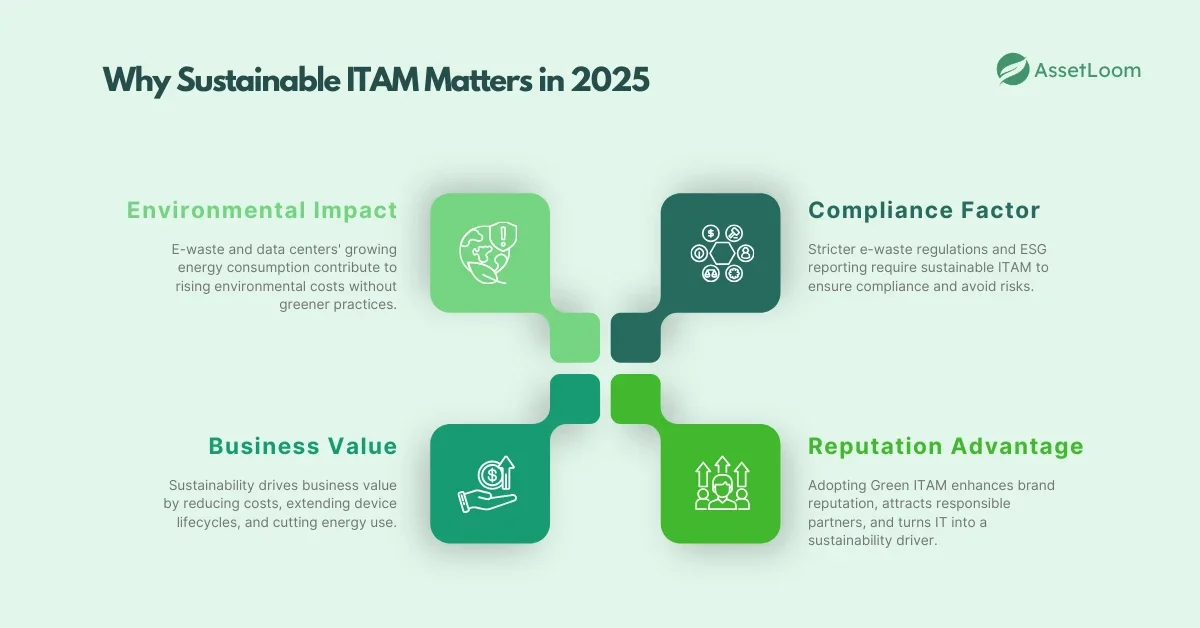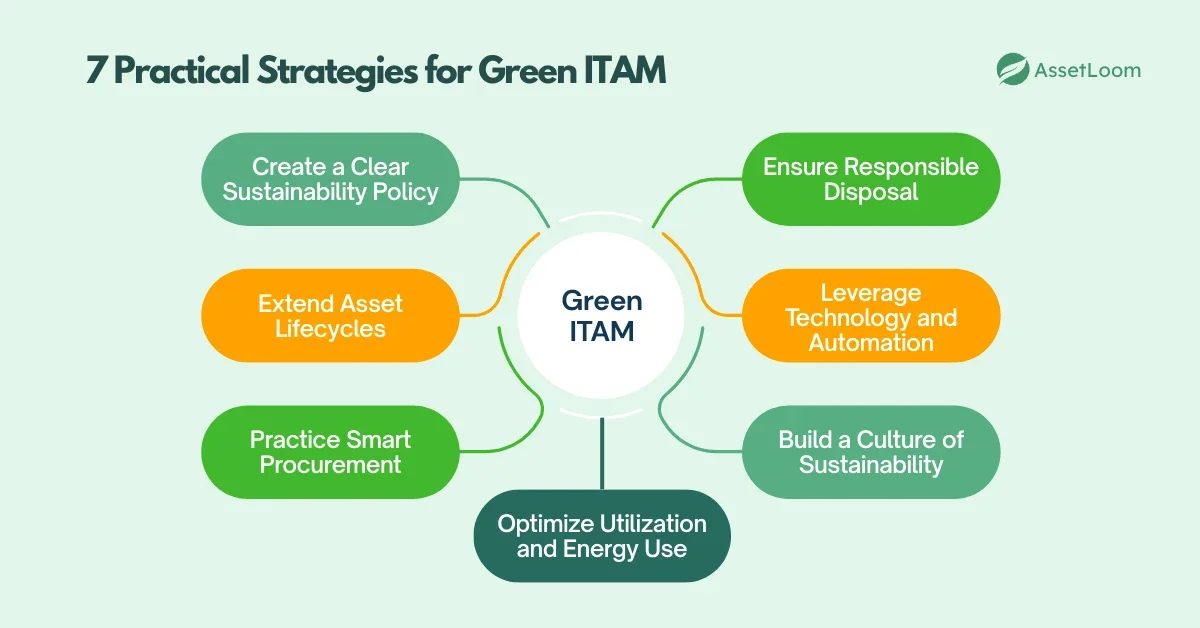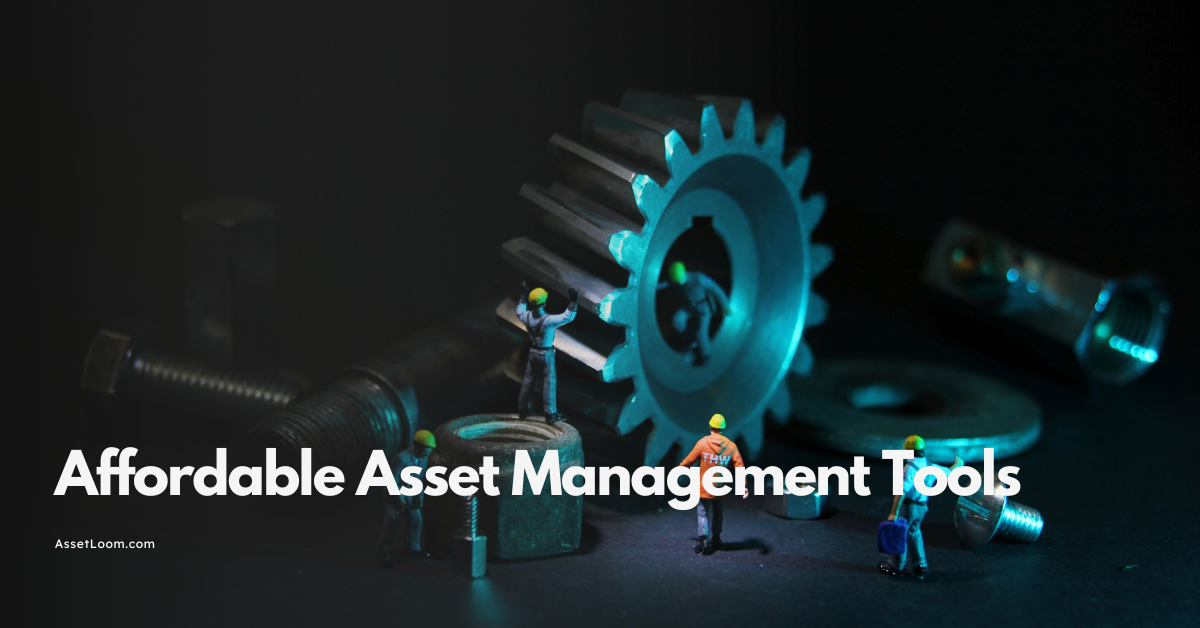Green IT: Sustainability in IT Asset Management for 2025
Sustainable ITAM is about progress, not perfection. Each decision moves your organization closer to efficiency, responsibility, and resilience.
In 2025, sustainability is no longer a nice-to-have. It has become a business priority. From the energy that powers data centers to the constant cycle of device upgrades, technology has a real impact on the planet.
This is where IT Asset Management (ITAM) plays a new role. What used to be about tracking hardware and software is now also about making smarter, greener choices.
The move toward Green ITAM is not only good for the environment. It can also save money, keep companies compliant, and build trust with employees and customers. In this blog, we will look at what Green IT means, why sustainable ITAM matters today, and how to put it into practice in clear, practical ways.
What is Green IT and Sustainable ITAM?
When people hear the term Green IT, they often think of recycling old laptops. That is part of it, but it is only the beginning. Green IT is the broader idea of designing, using, and managing technology in ways that reduce its environmental impact. It asks questions like: How much energy do our systems consume? How long do our devices last before they are replaced? What happens to them when they reach the end of their life?
Think of Green IT as a mindset. It is about making technology work not just for productivity, but also for the planet.
Now let’s bring that mindset into the world of IT Asset Management (ITAM). At its core, ITAM is the discipline of keeping track of a company’s technology — laptops, servers, mobile devices, software licenses, and more. Traditionally, the goal was to control costs, reduce risks, and make sure assets were used efficiently.
Sustainable ITAM expands this mission. It still covers cost, compliance, and efficiency, but adds a new layer: environmental responsibility. In practice, that means:
- Buying smarter: choosing equipment that is energy-efficient, durable, and backed by vendors with recycling programs.
- Using smarter: keeping assets in good condition through maintenance and upgrades, and redeploying them across teams instead of buying new.
- Disposing smarter: recycling responsibly, wiping data securely, and donating or reselling devices where possible.
Green IT sets the vision, and sustainable ITAM is how organizations put that vision into action. It is where business value and environmental responsibility meet.
Why Sustainable ITAM Matters in 2025
If Green IT and sustainable ITAM define the “what,” the real question is “why now?”. The answer is simple: technology is growing faster than our ability to manage its impact, and 2025 is a turning point.

1. The Environmental Impact
E-waste is one of the fastest-growing waste streams in the world. Millions of devices are retired every year, many still functional, and only a fraction are properly recycled. At the same time, data centers are hungry for power. In 2022, U.S. data centers used about 2.5% of the country’s electricity. By 2030, that figure could triple. Without greener IT practices, the environmental cost of technology will keep climbing.
2. The Business Value
Sustainability is not just about doing good, it is also good business. Extending device lifecycles, optimizing workloads, and reducing power use can unlock major cost savings. For example, a company that stretched its laptop replacement cycle from three years to five saw both a 40% reduction in e-waste and more than half a million dollars saved annually in procurement and energy costs.
3. The Compliance Factor
Governments and regulators are stepping in. From stricter e-waste rules to new ESG reporting requirements, organizations are expected to prove that they are managing technology responsibly. A sustainable ITAM program ensures compliance and reduces the risk of fines, penalties, or reputational damage.
4. The Reputation Advantage
Customers, employees, and investors are all watching how companies handle sustainability. Organizations that adopt Green ITAM are not just cutting costs — they are also building stronger brands and attracting people who want to work with responsible businesses.
In short, sustainable ITAM matters in 2025 because it checks every box: it protects the planet, reduces expenses, keeps you compliant, and strengthens your reputation. It transforms IT from a cost center into a sustainability driver.
7 Practical Strategies for Green ITAM
Sustainable ITAM sounds great in theory, but what really matters is how to put it into practice. The good news is that you do not need to reinvent your entire IT strategy. Small, practical steps can add up to major cost savings and real environmental impact. Here are seven strategies that IT managers and business leaders can start applying right now.

1. Create a Clear Sustainability Policy
Think of this as your roadmap. A sustainability policy defines goals like reducing carbon emissions, extending device lifecycles, or cutting e-waste. Without it, efforts can feel scattered or inconsistent.
For example, a global consulting firm set a goal to recycle 90% of its retired laptops by 2025. With that clear target, IT teams knew exactly what to measure and report. The policy made sustainability part of daily ITAM work, not just a side project.
2. Extend Asset Lifecycles
Replacing devices every three years has been the industry habit. But with regular maintenance, upgrades, and repairs, many assets can last five or even six years. Redeploying older but functional laptops to roles that require less computing power is another smart move.
Every extra year of use saves money on procurement and keeps thousands of devices out of the waste stream. It also reduces the carbon footprint tied to manufacturing and shipping new hardware.
3. Practice Smart Procurement
The choices you make at purchase time ripple across the asset’s entire life. Look for devices that are durable, energy-efficient, and easy to repair. Give preference to vendors who offer take-back or recycling programs.
One CIO described it this way: “Buying cheap laptops looked like a cost win up front, but the constant replacements created hidden costs. Once we switched to higher-quality machines with vendor recycling, total cost of ownership went down and our ESG reports looked better too.”
4. Optimize Utilization and Energy Use
Most companies own more hardware than they actually need. Idle devices sit on desks, servers run at 20% capacity, and cloud workloads spin up without being shut down. ITAM tools can shine a light on these inefficiencies.
A simple step like enabling automatic sleep modes on laptops or optimizing cloud workloads can translate into big savings. One financial services firm cut data center energy use by 25% just by consolidating underused servers.
5. Ensure Responsible Disposal
When assets reach end-of-life, how they are handled matters. Partner with certified IT Asset Disposition (ITAD) providers to ensure secure data wiping and environmentally safe recycling. Where possible, donate or resell devices to extend their use.
This isn’t only about the planet, it’s also about trust. Mishandled disposal can lead to data breaches, fines, and reputational damage. Responsible ITAD protects both the business and the environment.
6. Leverage Technology and Automation
Manual tracking is not enough anymore. Modern ITAM platforms, AI, and analytics can monitor asset health, flag underused equipment, track energy consumption, and automate reporting.
For instance, some organizations now use AI tools to predict when devices will need replacement, allowing them to refurbish early and extend useful life. Others generate automatic reports for ESG compliance, saving countless hours for IT managers.
7. Build a Culture of Sustainability
Technology alone cannot drive change, people need to be on board. Train employees on simple practices like powering down unused equipment or delaying upgrades when devices are still functional. Recognize and reward teams that contribute to sustainability goals.
Culture is what makes sustainable ITAM stick. When staff understand why it matters, they are more likely to support decisions like extending device use or donating retired assets.
These 7 strategies are not about doing everything at once. Start small write a policy, pilot an ITAD program, or extend the lifecycle of one device category. Each step builds momentum, saves money, and reduces impact. Over time, the gains compound, and sustainable ITAM becomes simply “the way you do IT
Common Challenges and How to Overcome Them
Shifting to sustainable IT Asset Management sounds straightforward on paper, but many organizations run into familiar challenges. The good news is that each of these obstacles has practical solutions.
1. Upfront Costs
High-quality, energy-efficient hardware or new It asset management tool often come with bigger price tags. That can make green choices a tough sell to finance teams.
How to overcome it: Focus on total cost of ownership rather than sticker price. Extending a laptop’s life by two extra years or consolidating servers often saves far more than the initial investment. Also, explore green grants, vendor incentives, or tax breaks that can offset upfront costs.
2. Data and Reporting Complexity
Sustainability metrics can feel overwhelming. How do you measure energy use across thousands of devices? Or track how much e-waste is recycled?
How to overcome it: Use ITAM platforms and automation to capture the data for you. Many modern tools can generate compliance-ready reports, making ESG tracking less of a burden and more of a byproduct of everyday IT operations.
3. Supply Chain Challenges
Even with the best intentions, companies may face limited options if vendors do not offer eco-friendly products or recycling programs.
How to overcome it: Start by setting vendor expectations in procurement policies. Choose suppliers with sustainability certifications, and phase in greener vendors over time. If choices are limited, prioritize extending lifecycles of the assets you already own.
4. Balancing Performance and Sustainability
Some IT leaders worry that extending device lifecycles will slow down performance or frustrate employees.
How to overcome it: Match the right hardware to the right role. A refurbished laptop may not suit a developer running heavy workloads, but it might be perfect for an employee who only needs email and web access. Smart redeployment avoids performance trade-offs.
5. Change Resistance
Finally, people may resist new practices, especially if they think sustainability means “doing more with less.”
How to overcome it: Communicate the benefits clearly, lower costs, better compliance, and a positive impact on the planet. Share success stories from within the company, and recognize employees who support green IT practices. Change feels easier when people see the upside.
Sustainable ITAM is not without its hurdles, but none of them are deal-breakers. With the right tools, policies, and mindset, these challenges can turn into opportunities for efficiency and innovation.
Looking Ahead: The Future of Green ITAM
Sustainable ITAM is no longer a side project. It is fast becoming the standard way organizations manage technology. Looking toward the next few years, several trends are shaping that future.
- Circular IT Becomes the Norm
The idea of a “take, use, throw away” lifecycle is fading. In its place, companies are adopting circular IT models, where assets are repaired, refurbished, redeployed, or recycled. This reduces costs, keeps equipment in circulation longer, and cuts e-waste dramatically.
- AI and Automation Drive Efficiency
Smarter tools are already changing ITAM. AI can predict hardware failures before they happen, recommend when to refurbish instead of replace, and optimize workloads to save power. Automation will make sustainability reporting and compliance tracking easier than ever.
- Sustainability Reporting Gets Stricter
Governments and investors are tightening expectations. ESG reporting is becoming mandatory in many regions, and IT assets are a measurable part of those disclosures. Organizations will need to show how they manage energy use, e-waste, and supply chains not just promise improvement.
- Green Innovation in Infrastructure
Data centers are moving toward renewable energy, advanced cooling systems, and hardware designed to consume less power. Forward-looking companies will take advantage of these innovations to lower both emissions and operating costs.
The future of ITAM is green by default. Organizations that act early will not only reduce risks and costs but also position themselves as leaders in sustainability. Waiting too long may mean playing catch-up with regulations, competitors, and customer expectations.
=> IT Asset Management Trends 2025: What IT Teams Need to Prepare For
Conclusion
Making IT Asset Management more sustainable does not require an overnight transformation. Small steps: extending device lifecycles, choosing greener vendors, improving disposal quickly add up to lower costs, reduced waste, and stronger compliance.
Sustainable ITAM is about progress, not perfection. Each decision moves your organization closer to efficiency, responsibility, and resilience.
Now is the time to act. Review your IT strategy, start with simple wins, and build momentum toward a greener, smarter future.

Subscribe for Expert Tips and Updates
Receive the latest news from AssetLoom. right in your inbox


